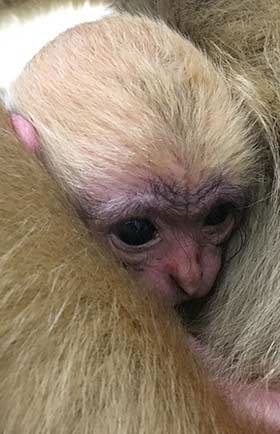Look for new furry faces in the New Year
Thursday January 3, 2019
Visitors to Stone Zoo will see new furry faces in the New Year with the recent births of bush dog puppies and a white-cheeked gibbon baby.
On November 25, Valentia, a female bush dog, gave birth to two tiny pups inside the cozy nest box set up by zookeepers. At birth, the pups, who are not much bigger than a hamster, are completely helpless and rely solely on their parents, both of whom help to raise them. The pups, currently weighing a little over 2 pounds each, opened their eyes on December 13, and were fully mobile by December 22.
“Valentia and her mate Mato have been attentive first-time parents, and have been observed carrying the pups. As with any birth, we are closely monitoring the pups and mom. We are very encouraged as everything has been going well so far, and the pups have hit important developmental milestones. They ventured out of the nest box on their own for the first time on December 28,” said Pete Costello, Assistant Curator of Stone Zoo.
Stone Zoo welcomed bush dogs to the animal family when the immersive new Caribbean Coast exhibit opened last June. The female came from the Prague Zoo in the Czech Republic, while the male arrived from Sequoia Park Zoo in California. The pups’ birth is a first for Zoo New England, and is the result of a recommended breeding by the Bush Dog Species Survival Plan (SSP), a cooperative, inter-zoo program coordinated nationally through the Association of Zoos and Aquariums. SSPs help to ensure the survival of selected species in zoos and aquariums, most of which are threatened or endangered, and enhance conservation of these species in the wild.
Listed as a near threatened species by the International Union for the Conservation of Nature (IUCN), these small mammals can be found in extreme eastern Central America and northern South America, south to Paraguay and northeastern Argentina. Formidable hunters, their size and shape make them uniquely adapted for life on the forest floor, while their webbed feet make them good swimmers.
It will likely be a few months before the pups make their exhibit debut, as they need to continue spending time bonding with their parents in the nest box. It must be at least 45 degrees for the bush dogs to be on exhibit. Until they make their exhibit debut, the pups and their parents will be in their cozy space behind the scenes.
 Stone Zoo celebrates another little arrival! Iggy, a white-cheeked gibbon, gave birth on November 16. The baby gibbon, whose sex is not yet known, has been holding on tightly to its mom. Iggy and her mate Kien are also parents to Jian, a young male gibbon. Zoo New England’s Stone Zoo participates in the White-cheeked Gibbon SSP.
Stone Zoo celebrates another little arrival! Iggy, a white-cheeked gibbon, gave birth on November 16. The baby gibbon, whose sex is not yet known, has been holding on tightly to its mom. Iggy and her mate Kien are also parents to Jian, a young male gibbon. Zoo New England’s Stone Zoo participates in the White-cheeked Gibbon SSP.
“The gibbon family is doing very well. In the first few days following the birth, Kien and Jian were quiet and did not go near Iggy and the baby. Within a week though, the entire family could be seen hanging out together and big brother Jian was observed grooming the baby,” Costello said.
White-cheeked gibbons display a rather extreme form of sexual dimorphism (physical differences between the genders) – the males are nearly all black while the females are nearly all cream colored. However, all white-cheeked gibbons are born with a light-colored coat that resembles their mother’s coloration, which helps to camouflage them.
IUCN categorizes this species as critically endangered as the population has declined by at least 80 percent in the past 45 years due to hunting and habitat loss.
Gibbons are apes, not monkeys, and are social animals, living in small, stable family groups consisting of a mated pair and their juvenile offspring. Native to Southeast Asia, these animals spend most of their lives in trees and move by swinging between branches and vines using their arms (this is called brachiating). They are incredibly agile and can leap across gaps in the tree canopy up to 30 feet.
The white-cheeked gibbons are currently bonding together behind the scenes. It must be at least 50 degrees for the gibbons to be on exhibit.

